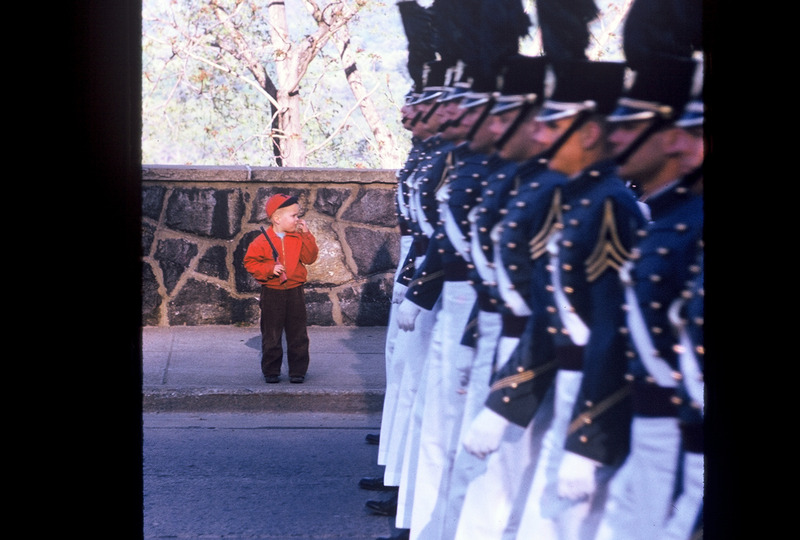Life on the Post
Now Life on the Post at West Point was pretty normal for Patsy and I and our still quite young David. With its Post Exchange, Commissary, Thrift Shop - always of interest to Patsy - and with a very stable population, life felt 'small town community' pleasant.
In our 1890s home, we were only a short walk to an Apartment building where those married families without children lived, and the Cadet and Post Library, or 'Grant Hall' - where friends or family of cadets could meet - and from where the parade ground was easily accessible. While car parking was always tight, Patsy could walk to the Plain and enjoy the frequent Cadet Parades.
Right below our home was Thayer Road that linked the Cadet area with the Thayer Hotel and South Gate, about a mile further south. Cadets who were to march in parades in New York or Washington DC often practiced by marching the mile length of Thayer Road. Very young David really enjoyed watching those practice marches right from the sidewalk across from our house - as he appears in the photograph below.

And always at 5PM, the Canon would boom, while a bugler played Retreat, and the high-masted flag would come down from less than a mile north of our house. All auto traffic was expected to stop within earshot of that daily ceremony, occupants exit the vehicle, and male military to salute while others put their hand over their heart.
Many a New York civilian family driving through the post on the main road that loops around the parade field and next to Trophy Point where the canon and bugler are, got caught in the stopped traffic, and somewhat alarmed everyone who then bailed out of their car and stood, sheepishly, as the flag went down.
They thus learned a lesson in military, West Point, and the 200 year long tradition of the end of duty day ceremony of 'Retreat.'
In the morning what were called 'The Hell Cats' - the drum, bugle section of the Academy Band played at 6:00 AM Reveille while the flag went up. All to get the Cadet Corps moving. But without a canon fired in the morning we could not really hear it in our quarters, down Thayer Road, as we could Retreat.)
Patsy was able, as soon as we got settled, to find where Cindy and Charlie Adams - also in the English Department - lived. They lived in rather obsolete set of frame quarters at the far end of the growing-population Post called 'The Gray Ghosts'. But even that was only 10 minutes by car away.
So Patsy and Cindy, with their children, often drove to antique stores, and local sights with their kids.
Early American History
The Academy itself had plenty of Revolutionary War Era historical sites, markers, and monumnts to see - though generally they were visited when we officer faculty members, who learned their history when we were cadets were around.
Especially the 'Old' Chapel and very old West Point Cemetery - which dated back to the 1775 Revolutionary War - was worth several visits.
One of the most interesting series of plaques is high on the wall of the Old Chapel. Each plaque contains the Rank, Name, and inclusive dates when that General was Commander of West Point.
There is a Plaque which marks the time when traitor General Benedict Arnold commanded West Point in 1776. BUT while the word 'Major General' is there, and his birth year, the NAME has been gouged out! No American Traitor, even though he commanded West Point, will be honored on This Post!

